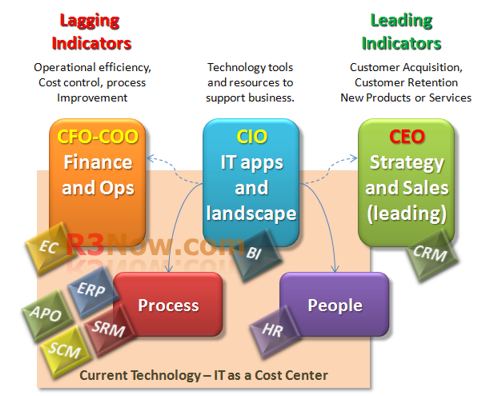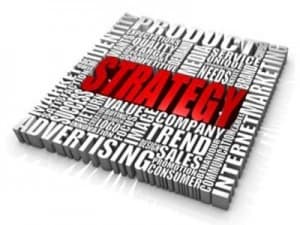This is the third part of an ongoing series about where the application technology market is today, including ERP vendors such as SAP and Oracle, and where the market is headed. The series provides insight on how to get ahead of the current trends and ride the wave that is building rather than getting swept away with it. The current business trends and market forces for technology will reward the swift and adaptable who are able to address the key business areas that have been lacking in the technology space, but it will severely punish those who lag behind.
Today’s Technology Landscape and IT’s Alignment (or Misalignment) with Business Priorities
For far too long, ERP and technology implementations have only focused on one of the three key value propositions– the pillar of operational excellence with aspects such as process improvement or quality management. This pure operational focus ignores the critical component of business: customers. From a business metrics perspective (or Operational business metrics instead of Key Performance Indicators [FN1]), the focus on operations, automation, quality, and other business process management alignment with technology only deals with lagging indicators to business health and success.
Unless your products, services, or markets are commodity based, this is a dangerous approach. This approach is like having tactics without a strategy. They tend to be “knee jerk” and reactive rather than planned and proactive.
The entire industry is filled with unqualified consultants and technology solutions to address current state business health and performance. They only deal with lagging indicators that are after the fact and do not help business move forward. Nearly all of today’s technology solutions, as provided by technology vendors and consultants, only address operational excellence propositions and do very little to address business value propositions or competitive pressures focused on customers and innovation. With SAP in particular, the functionality is available to address all of these business concerns, but few consultants and even fewer vendors have any idea how to approach these key business areas. They only work in the area and arena of business tactics. These consultants and vendors have little understanding or idea of the business functionality related to competitive pressures or how to set it up– or even more basically, how to extract the key requirements from the business for scoping or blueprinting.
“Tactics without strategy is the noise before defeat.” – Sun Tzu
Technology to Business Alignment Landscape – A Patchwork of Lagging Indicators Is the Wrong Direction
The graphic below shows the common consulting-driven application patchwork that most CIO, IT Director, or IT decision makers implement and maintain. Note that it is a hodge-podge of systems, creating a difficult-to-manage relationship that distorts the technology relationship with the business. Today, most systems and technology focus on the lagging indicator side of the business, on the financial side, or on the cost control/efficiency side of the equation. Current system integrator and consulting direction does not properly align technology with where business is actually done– at the customer facing points of interaction. From a genuine business perspective, can you see where the misalignment of technology is?
- EC = Enterprise Consolidation: inter-company or multi-company financials.
- APO = Advanced Planning and Optimization: advanced production and service planning, logistics, and supply chain capabilities.
- ERP = Enterprise Resource Planning: integrated back-office systems for managing sales, procurement, inventory, financials, etc.
- SRM = Supplier Relationship Management: vendor, procurement, and supply management including vendor marketplace bidding portals.
- SCM = Supply Chain Management: sometimes another “flavor” or style of APO, or additional transportation and warehousing functionality.
- BI (or BW) = Business Intelligence or Business Warehouse: data warehousing and reporting.
- HR (HRM, HCM) = Human Resources, Human Resource Management, or Human Capital Management: HR processing.
- CRM = Customer Relationship Management: usually a large contact management system.
Notice that the current system integrator technology solutions are not focused on correct business and IT alignment; in other words, current approaches to technology are not integrating technology and IT spend with business. The current technology landscape that software vendors promote, system integrators support, and consultants understand contains only one area focused on leading indicators– CRM. In some instances, where the business insists, BI/BW reports may integrate data for meaningful leading indicator evaluation. This only seems to happen when initiated by the business (generally not by the consultants). Even in the area of CRM, few “consultants” have any idea about customer acquisition or customer retention. As a result, most CRM applications are little more than glorified contact management systems.
Far too often today, I see and hear technology consultants advocate for process improvements, as if that last mile of automation, or that last small amount of incremental improvement, will somehow make a breakthrough in your company’s market position. Keep in mind that this statement and criticism of the focus on constant “process improvement” comes from an insider, a “process expert” in the supply chain area around Sales and Distribution as well as Materials Management. So, this criticism is not from an outsider and even affects the entire range of solutions I generally consult in. However, one key difference is that I work to bring a dimension of those business concerns to every project I do.
“[B]usiness executives said the top IT priority and most important business driver (cited by 53 percent of those surveyed) was acquiring and retaining customers. Yet how well did IT actually support that mission during the past year? Nearly 50 percent of the business execs judged IT’s performance as ‘fair’ or ‘poor.’ Another 5 percent said IT did not support acquiring or retaining customers at all. Business execs’ ratings of IT’s impact on managing customer relationships were equally bad.” Thomas Wailgum, “Enterprise Software Unplugged,” February 20, 2009, CIO Magazine online. http://advice.cio.com/thomas_wailgum/why_the_recession_is_marginalizing_cios
If the operational value proposition is not what the future holds, and if there are higher and higher costs but smaller and smaller returns on investment, where is the next big technology opportunity? Think of it like this: if lagging indicators represent “supply” and leading indicators represent “demand,” and you focus on improving the supply side but do nothing for demand, you end up with a collapsing business model.
In other words, the process improvement or operational excellence model leads to a lot of capacity and a need for more customers to fill that capacity. As competitors across the board all have focused on these process improvements, and as they have all gained capacity, you must lower your prices to continue to fill the capacity pipeline. This is the “supply side” of business. However, what is actually needed is the “demand side,” where you can find customer retention, customer acquisition, and innovative products or services.
The entire technology sector must focus on customers and on innovation. Without customers, there is no business; without innovation, products and services become commodities that only compete on price. IT has an opportunity for innovation and leading edge business solutions using technology, not technology solutions that use business.
[FN1] Using Key Performance Indicators for Building a Strategy Focused Organization and Why Indexed KPIs are Critical for Business Performance and Success
Part 1: What is the Proper Relationship for the CIO, CEO, and CFO?
In the first part of this series, we looked at the changing business landscape and what it means to the CIO, it director, IT Manager, and other key technology decision makers. From a high level, the current global business competition, as well as economic issues, are directly affecting the C-level executive requirements and the CIO–CFO–CEO dynamic. This article reviews how and where the CIO role is under tremendous pressure, and how to change the current dynamic by more appropriately partnering with the CFO and the CEO. This partnership is a critical business bridge between lagging business indicators of business health on the CFO–coo side of the business house, and the leading indicators of sales and product or service pipelines on the CEO side of the business house.
Part 2: CIO, CFO, and CEO Alignment – Why ROI is Lacking from Today’s System Landscape
The second part is an overview of the current system landscape and its focus on business processes and the customer. This piece also looks at the future business landscape and how the technology focus and direction will be permanently changed, no matter what happens with the economy and global competition. Because the technology marketplace (business consumer) is becoming more sophisticated and more attuned to business/technology alignment, the IT dynamic is going through a structural change. The whole technology sector is slowly moving away from the operational excellence value proposition to the customer focus and innovation areas of the business. Few of the consulting companies and application vendors see this change and are doing little to address it. This is the area of technology market winners and losers of the next twenty years.
Part 3: Changing the Direction of SAP, ERP, and IT Applications to Focus on the Customer and Innovation
The third part in the series looks at current technology landscapes and how they are aligned. In addition, the article looks at future technology landscapes. A brief review of the supply and demand side of business shows that unless you have lots of customers (demand) to fill a bigger and bigger pipeline (supply), then your business model collapses. While it is hidden during good economic climates, any disruption in those economic conditions that fails to fill the capacity pipeline points out the glaring insufficiency of the operational focus to technology. During any economic disruption, or any reduction in demand from customers for your products or services, the current technology model falls apart.
Part 4: Future Technology Landscape Alignment for the CIO, IT Director, or Key IT Decision Maker
The final part of the series looks at the emerging technology landscape and what the future holds. It lays out an emerging technology landscape model, which has some realignment and components already in use by some of the world’s most successful companies. A new alignment of technology with the customer-facing processes, as well as the use of social or collaboration tools across the enterprise, is explored. The driver for the future change will be because the business does not see the revenue generation prospects of technology. They fail to see the possibilities of promoting customer retention, customer acquisition, innovation, and marketplace analytics. The new technology model looks to change that dynamic.







